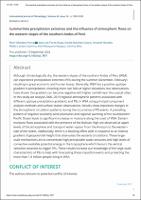Mostrar el registro sencillo del ítem
Summertime precipitation extremes and the influence of atmospheric flows on the western slopes of the southern Andes of Perú
| dc.contributor.author | Villalobos-Puma, Elver | |
| dc.contributor.author | Flores-Rojas, Jose Luis | |
| dc.contributor.author | Martinez-Castro, Daniel | |
| dc.contributor.author | Morales, Annareli | |
| dc.contributor.author | Lavado-Casimiro, W. | |
| dc.contributor.author | Mosquera-Vásquez, Kobi | |
| dc.contributor.author | Silva, Yamina | |
| dc.date.accessioned | 2023-01-12T15:01:15Z | |
| dc.date.available | 2023-01-12T15:01:15Z | |
| dc.date.issued | 2022 | |
| dc.identifier.uri | https://hdl.handle.net/20.500.12542/2584 | |
| dc.description.abstract | Although climatologically dry, the western slopes of the southern Andes of Peru (WSA) can experience precipitation extremes (PEs) during the summer (December–February) resulting in great economic and human losses. Generally, WSA has a positive upslope gradient in precipitation, meaning more rain falls at higher elevations, but observations have shown this gradient can become negative with higher rainfall near the coastal cities. In this study we analyse 2000–2019 regional atmospheric patterns associated with different upslope precipitation gradients and PEs in WSA using principal component analysis methods and surface station observations. Results show important changes in the atmospheric circulation patterns during the occurrence of PE events. A prevailing pattern of negative southerly wind anomalies and regional warming of the southeastern Pacific Ocean leads to significant increases in moisture along the coast of WSA. Eastern moisture flows associated with the presence of the Bolivian High are observed at upper levels of the atmosphere and transport water vapour from the Amazon to the western side of the Andes. Additionally, there is a blocking effect aloft in response to an intense gradient of geopotential height that attenuates the easterly circulations. These large-scale mechanisms act to concentrate high precipitable water amounts and high levels of convective available potential energy in the troposphere which favours the vertical velocities essential to trigger PEs. These results increase our knowledge of the large-scale characteristics of PEs to help with forecasting these impactful events and protecting the more than 1.8 million people living in WSA. | es_PE |
| dc.format | application/pdf | es_PE |
| dc.language.iso | spa | es_PE |
| dc.publisher | John Wiley and Sons | es_PE |
| dc.relation.uri | https://doi.org/10.1002/joc.7871 | es_PE |
| dc.rights | info:eu-repo/semantics/openAccess | es_PE |
| dc.rights | Atribución-NoComercial-SinDerivadas 3.0 Estados Unidos de América | * |
| dc.rights.uri | http://creativecommons.org/licenses/by-nc-nd/3.0/us/ | * |
| dc.source | Repositorio Institucional - SENAMHI | es_PE |
| dc.source | Servicio Nacional de Meteorología e Hidrología del Perú | es_PE |
| dc.subject | Andes | es_PE |
| dc.subject | Potential Energy | es_PE |
| dc.subject | Slope Dynamics | es_PE |
| dc.subject | Atmospheric Circulation | es_PE |
| dc.subject | Water Vapor | es_PE |
| dc.subject | Atmospheric Moisture | es_PE |
| dc.title | Summertime precipitation extremes and the influence of atmospheric flows on the western slopes of the southern Andes of Perú | es_PE |
| dc.type | info:eu-repo/semantics/report | es_PE |
| dc.identifier.journal | International Journal of Climatology | |
| dc.subject.ocde | https://purl.org/pe-repo/ocde/ford#1.05.09 | es_PE |
Ficheros en el ítem
Este ítem aparece en la(s) siguiente(s) colección(es)
-
Artículo científico [166]









